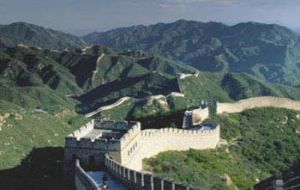MercoPress. South Atlantic News Agency
China's economy overestimated but is the world's second
 In today's global economy, China has become a force to be reckoned with
In today's global economy, China has become a force to be reckoned with The size of China's economy is overestimated by some 40%, but it remains the world's second largest using a ranking based on purchasing power, the World Bank said Monday.
In a report ranking the world's economies for 2005, the World Bank said its updated survey using "purchasing power parity" (PPP) shows a much smaller value for China than earlier estimates which the Bank called "less reliable." The study carried out by the World Bank and other partners was "the most extensive and thorough effort" to measure the relative size of 146 economies using the PPP method which strips out the effect of exchange rates, a Bank statement said. China participated in the survey for the first time and India for the first time since 1985. While the economies of China and other developing countries appear larger using the PPP method compared to using market rates, the new estimates include more reliable data on goods and services in China. Compared with the traditional market exchange rate methods, the PPP method is still somewhat controversial among economists. Using market methods, Japan would be the second largest economy and China would rank behind Germany, roughly equivalent to the economies of Britain and France, according to the World Bank report. The Bank had in the past extrapolated figures on China and India using the purchasing power method, but the latest report is based on more extensive data. "These results are more statistically reliable estimates of the size and price levels of both economies," the Bank said. "The previous, less reliable, methods led to estimates of their GDPs (gross domestic product) that were 40% larger than the results of the new, improved methods and benchmark". China still ranks as the world's second largest economy with over 9% of world production using PPP, but that compared with 14% under the old methodology. India is the fifth largest with over 4% of the world total. That is down from 6% using the previous method but up from two percent using market exchange rates. In the study, the United States still has the world's biggest economy with 23% of global output. That compares with 29% using market rates. Japan ranks third under the PPP method with 7% of global output. The study said the survey "should not be used as indicators of the under- or overvaluation of currencies." Albert Keidel, an economist at the Carnegie Endowment for International Peace who has studied China's economy and had earlier suggested that the Chinese economy was overestimated, said the new report highlights deeper poverty problems in the country. "This will mean there is even more of the population under the dollar-a-day poverty line than had been estimated," Keidel said. "China will continue to play a major locomotive role in the global economy; the size of China is of small importance. What matters is the growth of China and it's growing so rapidly." Traditional market estimates show China's output at 2.244 trillion dollars. The new PPP would make that 5.333 trillion, below the 8.819 trillion based on prior World Bank surveys. The PPP method shows the economies with the highest output per capita are Luxembourg, Qatar, Norway, Brunei, and Kuwait; the lowest are the Democratic Republic of Congo, Liberia, Burundi, Zimbabwe, and Guinea-Bissau. Another measure -- per capita individual consumption -- a measure of what households consume, suggests the richest economies are Luxembourg, United States, Iceland, Britain and Norway.




Top Comments
Disclaimer & comment rulesCommenting for this story is now closed.
If you have a Facebook account, become a fan and comment on our Facebook Page!